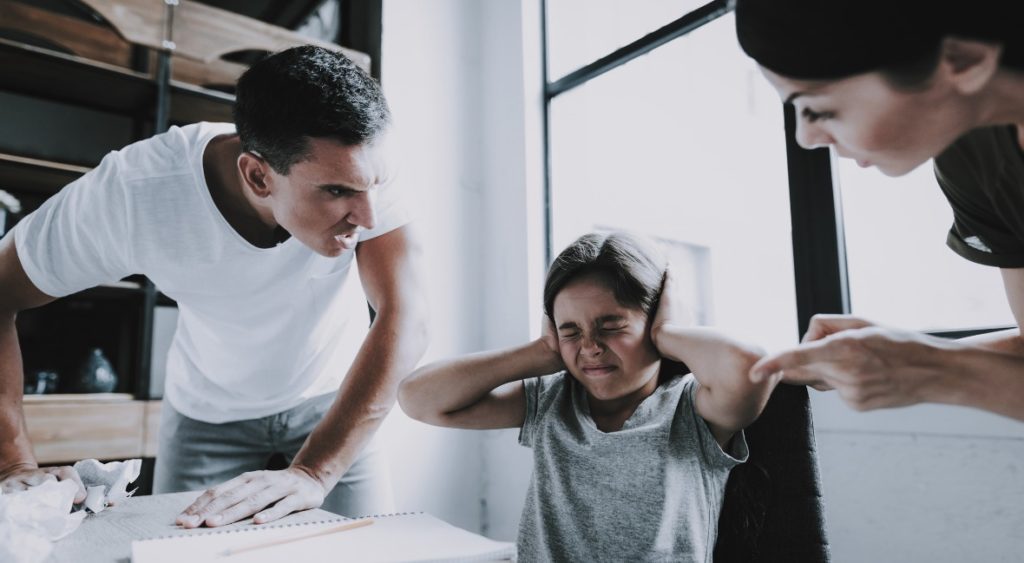Imagine this: your child does something you don’t like. Something “bad.” Maybe they lie to you or don’t listen or are throwing sand at the park. You want to make sure that they know that these things are bad. So you do a google search of punishments for kids to find the best way to handle the situation.
But when did we begin to think that making kids feel bad would make them do better? When your boss publicly shames you in the office or punishes you for a mistake that you made, does that inspire you to do your best work, to joyfully give it your all? No!
We’re here to show you why punishments for kids are less than ideal and what you can do instead. There is a middle ground between overly strict and permissive
Why are punishments ineffective?
Punishments are designed to make kids feel bad through shame, blame, or pain. Punishments include spanking, hand-slapping, timeouts, yelling, or taking away privileges or toys unrelated to the misbehavior.
Some parents believe that kids must feel bad to know that their actions are bad or that punishments must be severe to deter misbehavior. These parents don’t want kids to “get away with things.” But punishments do little to address why the behavior is happening and what could be changed.
Punishments may work to stop the behavior in the moment, but they have some adverse effects over the long term. Kids are taught to comply out of fear of us and what we might do to them. In effect, we’re saying, “Listen to me because I am bigger and scarier than you.” Punishments focus on external control by other people and do little to develop self-discipline.

The 4 Rs of Punishment
Dr. Jane Nelsen of Positive Discipline often talks about the harmful effects of punishments and what they’re genuinely teaching our kids. She has identified the adverse outcomes as the 4 Rs of Punishment:
- Resentment: the child becomes angry and upset about the punishment. This shifts the child’s focus away from what happened and onto the unfair nature of how they’re being treated. Anger is directed toward their parents, and that relationship is weakened.
- Rebellion: the child does the opposite of what the parent wants to show that parents don’t control them.
- Revenge: the child seeks to get even for how they’re being treated. In a revenge cycle, someone is always trying to win.
- Retreat: the child finds ways of being sneaky and not getting caught or believes themself to be a bad person. When kids retreat into sneakiness, they’re more worried about getting into trouble than about how their choices are impacting themselves or others [1]Nelsen, Jane. (2006). Positive discipline. New York: Ballantine Books..
Are any of those qualities you’d like to foster in your kids? No! Luckily, there are things you can do instead.
Switch the focus to finding solutions!
Instead of finding punishments for kids for things that happened in the past, we want to find solutions to help them do better in the future. This allows kids to be problem-solvers and take responsibility for their actions.
They become self-disciplined by considering how their actions impact their own life. We don’t want to raise kids who say, “I better not drive drunk because my mom will be mad.” We want them to grow up and think, “I better not drive drunk because I could hurt myself and others.”
How to Find Solutions WITH Kids
Kids need to be involved in the solution process when handling an issue. This way, it’s not simply parents imposing a solution onto them. Instead, they’re given a chance to practice their problem-solving skills.
Kids are much more creative than you might think and often come up with better solutions than we do ourselves. They’re also much more likely to take ownership of decisions and be willing to test them out when involved in the process.
Steps for Finding Solutions:
Begin by asking kids what happened. And truly listen to their response. This shows kids that your connection with them is what’s essential and that you’ll be there for them without jumping in, judging, or handing out punishments. This builds your relationship by teaching them that they can always come to you when they have a problem.
Next, ask kids why they think that happened. Again, ask this question because you’re curious. Listen to their response without offering your thoughts, judgments, or corrections. It can be enlightening to hear kids share why they did what they did. This can help you to further understand what might need to be changed.
Ask kids what can be done about it. These can be ideas about how to make it right in the moment and how to keep it from happening in the future. Here we are helping kids learn how to be accountable for their actions.
For example, if your kids broke a neighbor’s window with a baseball, they can think of ways to pay for the window now, and they can also think of ways to keep from breaking another window.
Encourage kids to throw out any solution they can think of because you can always cross things out later. If they can’t think of anything, you can begin by asking questions to help prompt them or ask if you can offer a solution. Have your child come up with many solutions and ask them which one they would like to try. Make sure that it’s something that works for both of you.
Finally, put a plan in place. This includes discussing how to implement the solution, how long you’d like to try it, and what will happen if they cannot follow the plan.
You can use these same steps to help kids process all sorts of problems they’re having beyond discipline issues. Maybe difficulty with friends at school or anxiety about something new.
Begin Using Solutions When Kids Are Very Young
You can begin using solutions even with babies and toddlers. When little ones do something less than desirable, remember that we’re looking to set it right, not make them feel bad. Putting it right is productive; feeling bad does nothing to fix what happened.
For Example:
Imagine that your just 2-year-old takes your cup of water and pours it over all their toys.
Avoid reacting in frustration and saying, “No! Why are you so naughty?! You know not to do that! You go sit in timeout!”
Instead, say, “Uh oh, there’s water all over. What can you do about it? Yes, that’s right. Go get a towel and wipe it up.”
You can then follow up with, “Water does not go on the toys. Let’s go to the sink/water table/outside to pour some water.” You might also want to think about not leaving your cup of water sitting on top of the toy shelf. Your curious toddler sees this as an invitation to pour.
What about consequences? Aren’t those a good alternative to punishments?
Consequences for kids are an extension of the solution-finding process. If you’re struggling to come up with a reasonable consequence, chances are what you need is a solution. When making a plan with kids and finding solutions, talk about the consequence that will be imposed if they’re unable to follow through on that plan.
This allows kids to know what the consequence will be ahead of time. Kids are given the power in these situations because they choose to follow or not follow the rule even knowing what will happen.
Let’s walk through an example:
Imagine your kids love to ride their bikes. But when called inside each evening, they’re taking longer and longer to come in or sometimes don’t listen at all.
You find a time to discuss this with them and work on finding a solution. Maybe they decided that it would be helpful if you gave them a five-minute warning. Together you decide that if they don’t come in when called, they won’t be allowed to ride their bike for two days as a consequence.
The next day, when called to come inside, if any of your kids choose to ignore you, you can say, “I see you chose to stay on your bike. It looks like you won’t be able to use it for the next two days. We’ll try again after that. ”
These are called logical consequences. Adults hand out these type of consequences. They work best when talked about ahead of time and must be related to the behavior, reasonable, and respectful to be effective.
Natural Consequences
There is another type of consequence that can be helpful for teaching kids: natural consequences.
Adults don’t hand out natural consequences. They’re what naturally follows when a child does something. For example, when they don’t eat, they’re hungry. When they don’t wear a jacket, they’re cold. Kids can begin to see the impact of their choices when allowed to face the consequences without adults rushing in to fix them.
There’s no need to talk about these consequences as kids can experience the effects. It’s best to avoid adding comments like “See, I told you so!”
There are times when using a natural consequence has an unacceptable outcome. For example, if a child runs in the road, the natural consequence is they could get hit by a car, but this is obviously not okay. Instead, if a young child continues to run into the road while at the park, maybe a logical consequence would be to leave the park.
Consequences can be effective when used as part of the bigger solution-focused approach. Remember, if the “consequence” uses shame, blame, or pain, it is a punishment in disguise and should be avoided.
Positive Characteristics Built Through Finding Solutions
Think about who you’d like your kids to be. Consider your family’s values and traits that you’d like for your kids. Are your interactions helping them grow into this person?
When you shift from punishments to solutions, you’re helping kids practice some excellent skills:
- Responsibility
- Problem Solving
- Honesty
- Self Discipline
- Empathy
- Creative Thinking
- Feelings of Being Capable
- Independence
- Conflict Resolution
- Decision Making
You’ll notice that punishments don’t help kids develop ANY of these positive character traits. See how punishments aren’t so effective after all?

Examples of Punishments vs. Solutions
You will notice that there are many different solutions to each of the issues in these examples, and we’re sure that you could come up with a bunch more. It’s important to see how each solution focuses on the specific situation at hand. There is never one blanket response for misbehavior.
Example 1:
You hand your phone to your 3-year-old so that they can watch videos. A few minutes later, your child drops the phone, and it goes crashing down on the tile floor.
How do your respond?
Punishment: you smack your child on the back of the head and say, “Be careful!”
- Does this help your child to be more careful? No.
- Does this help to protect the phone? No.
- Does this set limits? No
Solution: you take a moment to think about keeping the phone from getting damaged. Your child could sit down while holding it, you could sit with them while they watch videos, or you could get a special phone case. Decide what to do going forward and lay some ground rules for using the phone.
You might say, ” You can use the phone when you’re sitting down. If you start walking around, we will have to put the phone away and try another time.”
- Does this plan help to protect the phone? Yes.
- Does this plan give your child guidelines for using the phone? Yes.
- Does this plan set limits? Yes.
Example 2:
Your 15-year-old goes out with friends and says they will be home by 9 pm, but 9 pm rolls around, and they’re nowhere to be seen. They don’t answer any of your phone calls, and you have no idea where they are. By the time they arrive home at 10:45, you’re worried, angry, and frustrated.
How do your respond?
Punishment: You yell, “Where have you been! I’ve sitting here worried, and you couldn’t bother to send a text message? You’re grounded for the next two weeks!”
- Does your child feel loved in that moment? No.
- Are you treating your child respectfully? No.
- Does this put any systems in place to keep this from happening again? No.
Solution: When your child walks through the door, you say, “I am so glad that you’re safe and home. I’m feeling much too angry and tired to talk about this now. We’ll talk tomorrow.”
You find a calm and unhurried moment the next day to talk about what happened and why it happened. Maybe you learn that it’s tough for your child to be home by 9 pm when they see a movie with their friends. Together you decide on a later time they can come home on certain nights of the week as long as you know where they are.
You then discuss other solutions. There are a number of ideas that might be proposed. You can focus on solutions to keep them from being late, what they will do if they are late, and what will happen if they cannot follow through on the plan.
If your child says they have no ideas, you can say, “Take your time and think about it, but I can’t have you going out with your friends again until we have come up with something that works for both of us.” This will force them to do some problem solving and keep you from jumping in with all your ideas.
Maybe together you throw out some ideas like this –
Ways to keep you from being late:
- Plan a ride with mom ahead of time so you don’t have to rely on friends.
- Set a phone timer 30 minutes prior to needing to be home.
What to do if you’re going to be late:
- Call or text.
What happens if you’re late or do not call:
- Get your phone taken away for a few days.
- Mom calls the police because she must assume that there must be an emergency if you didn’t call.
- You can’t go out with friends for a determined amount of time and friends will have to come to your house.
- Spend together with family to make up for the time they were worrying about you.
You rule out unhelpful or disrespectful ideas and then pick some things to try. Maybe you and your child decide that they will set a phone alarm to help keep them on time and text you if they’re going to be late.
You decide that calling the cops might be a bit much, but your child won’t be able to go out with friends the following weekend if they don’t call when late. If they’re late more than 3 or 4 times, you decide that friends will have to come to your house for 2 weeks instead of your child going out.
- Are you building connection with your child through this discussion process? Yes.
- Are you setting clear boundaries and expectations? Yes.
- Is your child involved in the process? Yes.
Example 3
Your 6 year old becomes angry with you after school when you say no to eating ice cream and throws your hairbrush in the toilet.
How do your respond?
Punishment: You yell, “We don’t act like that in this house! You’re being a little brat, so now you cant go to your friend’s birthday party this weekend or have any dessert all week! Go sit in time out!”
- Are you helping to solve the problem of the now gross hairbrush? No.
- Are you giving your child ways to deal with their anger? No.
Solution: You can calmly say, “I see that you are very angry right now. It seems like you really wanted ice cream. Let’s take a moment to calm down.”
Once your child has calmed down, you can talk about what to do to fix the hairbrush and come up with strategies for managing their anger. Maybe they will suggest cleaning the hairbrush or saving up their allowance money to buy you a new one. You can discuss anger management strategies like deep breathing, setting up a calm down area, drawing pictures, or ripping paper.
You can also talk about when you’ll eat ice cream and what snacks they can pick from after school. You can even set up a little snack tub in the pantry or refrigerator that they can independently pick from. If they ask if they can have ice cream the next day after school, you can help them recall the new guideline by asking, “When will we have ice cream?”
- Does this plan help to solve the problem of the now gross hairbrush? Yes.
- Does this plan help your child to take responsibility for their actions? Yes.
- Does this help your child learn to regulate their emotions? Yes.
We hope that you’ll begin transitioning away from using punishments for kids and see there are discipline methods that help them grow into much better people. After all, our goal as parents is to raise capable and independent people who are ready to head out into the world.
Focus on finding solutions with your kids and follow through with consequences when necessary. Take time to listen, build connections, and demonstrate your love through clear and consistent boundaries.
If you’re looking for more
References
| ↑1 | Nelsen, Jane. (2006). Positive discipline. New York: Ballantine Books. |
|---|







No Comments